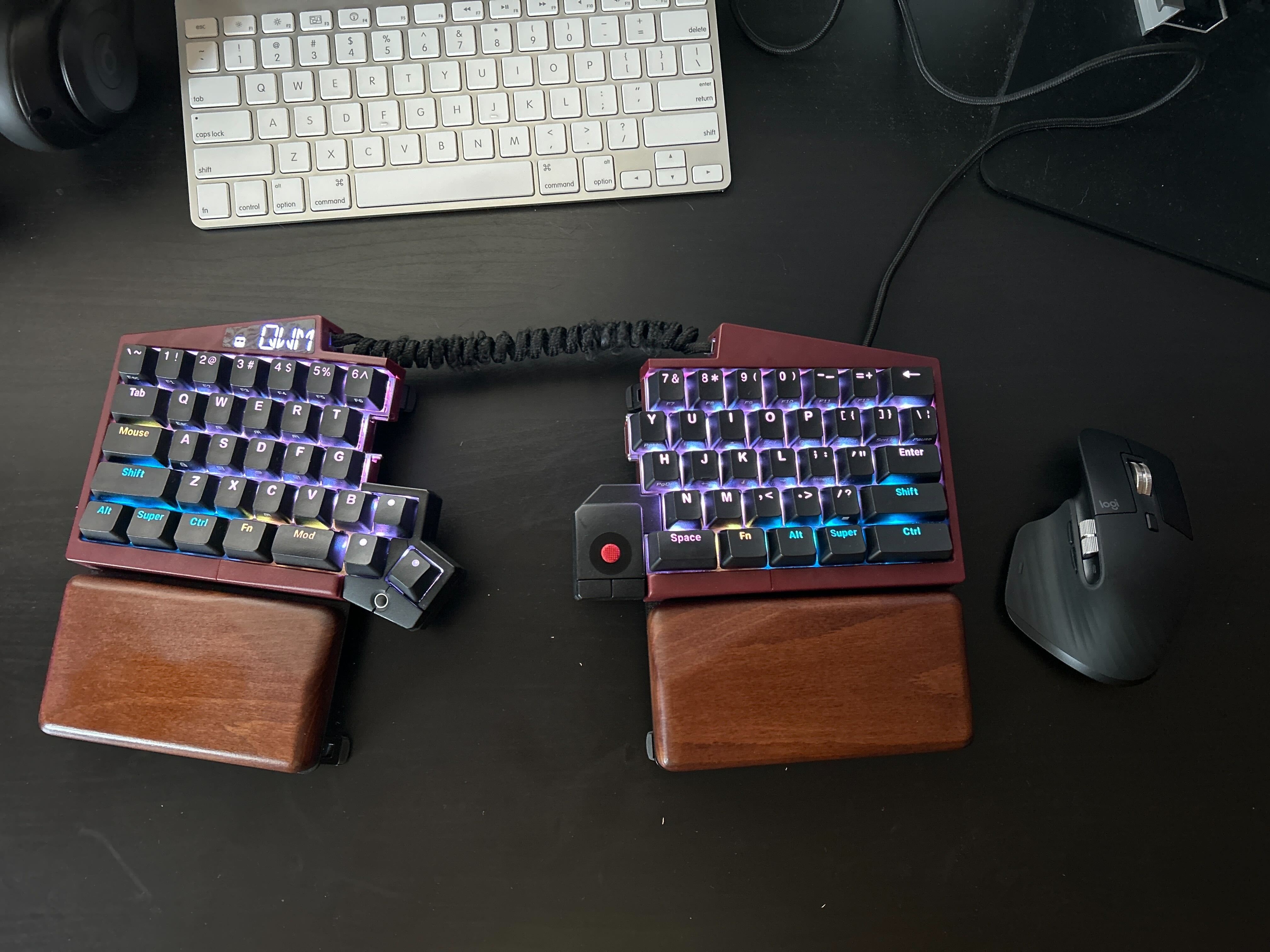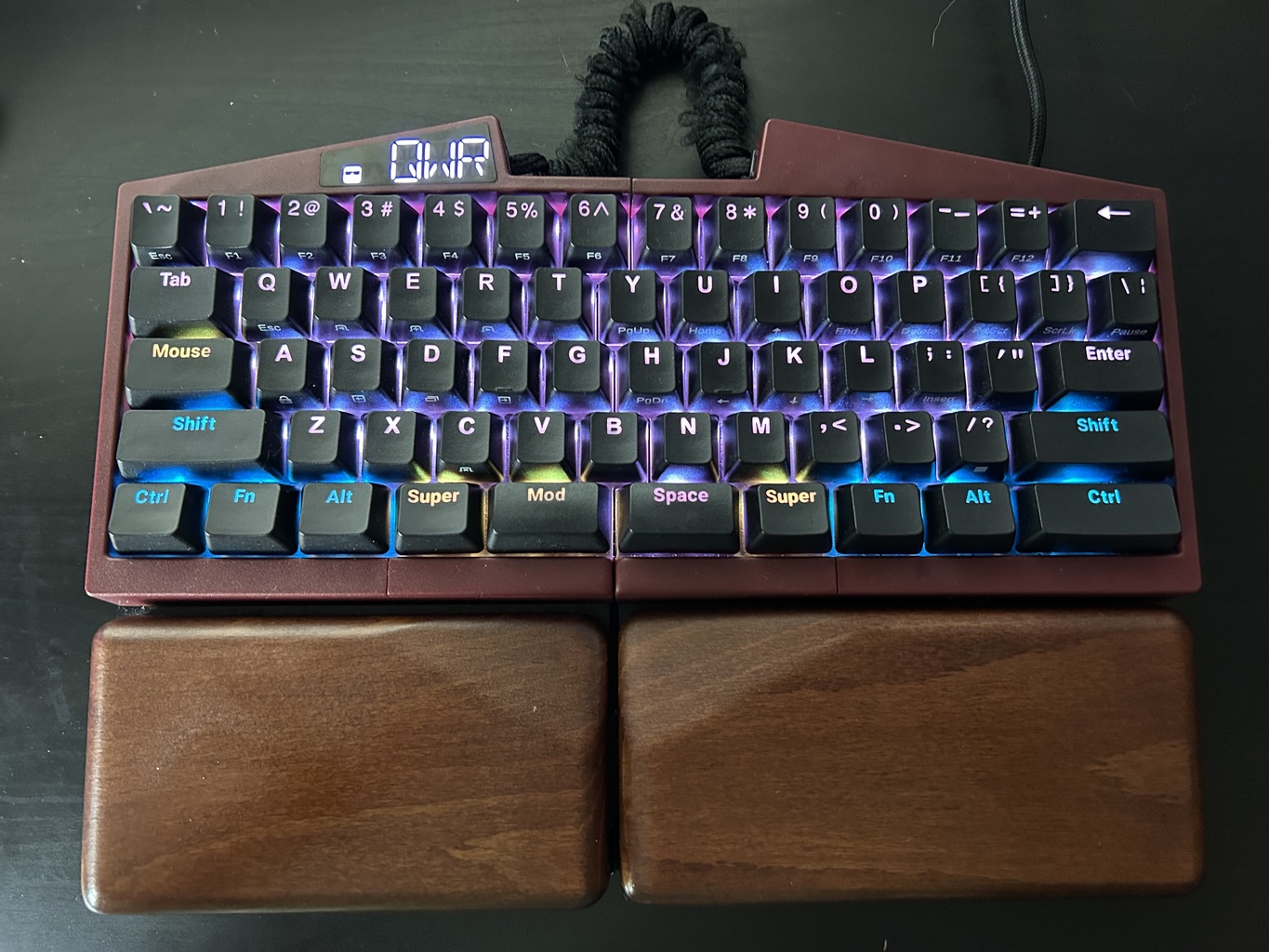I recently received some advice that I should set up a more ergonomic workstation at home: a split keyboard, an ergonomic mouse, and an adjustable sitting/standing desk.
I did a lot of research about keyboards and decided that an ortholinear or column staggered unit was not for me. I wanted something that would work in both split and one-piece configurations, and something somewhat close to what I already knew because I do frequently use the onboard keyboards on my laptops. In my research, I eventually discovered the Ultimate Hacking Keyboard. This is a fully programmable unit, with layers and macro support.
Right around the time I was looking for a new keyboard, a fellow employee in California listed his spare UHK60 v2 for sale, including a carry case and both the 3-key cluster and trackpoint modules, and I bought it.
I received it on Monday of this week, and I immediately plugged it in and started using it. I had never used a programmable keyboard before, and I had never used a split keyboard, and it has been 20 years or more since I last used a mechanical keyboard.
My previous keyboard was the Apple one -- I have a 2025 MacBook Air, a 2024 MacBook Pro, and an A1314 -- all have the same basic Apple layout (the newer ones have fingerprint sensors in the location where the old one had an eject key; this is the main difference). The UHK60 is a 60% keyboard, so when compared to the Apple keyboards I have used for decades, the UHK is missing the function keys, escape key, and arrow keys. All of these are accessed through layers on the UHK, a layer meaning that you press a modifier key (such as the UHK's Fn or Mod key) to access that key.
My first day was very rough -- I kept my A1314 close at hand, just behind the UHK, and I kept using the A1314 to do things that I had not sorted out how to do on the UHK. It was easy to get used to the split keyboard; it was difficult to get used to accessing keys through layers.
On Tuesday, the A1314 was a little farther away to the side, but I still used it quite frequently. By this point I had started reconfiguring the UHK to have it do what I wanted it to do... somewhat like how I decide where to put things in my house: Where will I look for that thing? When I found myself doing a particular key sequence for a function, I made that shortcut do that function, rather than always forcing myself to learn the default UHK shortcut for that function. This is, after all, the point of the UHK: you program it how you want it to operate.
The default UHK layout for the modifier keys matches that of a PC keyboard, not a Mac keyboard, so one other thing I did early on was to pull all of the modifier keycaps and reorder them to be more like the Apple keyboard, but I swapped the left function and left control keys, because the order of those two keys has always annoyed me on the Apple keyboard. Doing all that resulted in a much higher positive hit rate, and on Wednesday my old A1314 keyboard was at the edge of my desk, still powered on and available if I needed it, but I hardly used it. On Thursday the Apple keyboard was in the drawer, powered off.
There is much to learn here, and I am almost certainly going to change out the silent pink switches in this keyboard for something with at least tactile feedback, but most likely I will go with a clicky key. I am going to test out a few switches and then buy replacements.
At this point I greatly prefer the UHK over the Apple keyboard, and look forward to learning everything that it can do, and further tweaking it to best fit my usage.
As you can see in the first picture, I have also replaced my Apple Magic Mouse with a more ergonomic Logitech MX Master 3S. So far so good with that one.


Daniel's Blog
I am a system engineer in the Raleigh, NC area. My main interests are Unix, VMware, and networking. More about me, and how I got started.
Categories
Tags
- IC-7300 1
- T1 1
- ansible 2
- anycast 2
- atari 1
- autofs 1
- backup 2
- battery box 1
- bgp 1
- cables 2
- cisco 2
- dashcam 1
- digitalocean 2
- disney 1
- diy 6
- dkim 1
- dns 2
- docker 7
- dsm 1
- ecmp 1
- email 2
- encryption 1
- esp32 2
- esphome 2
- esxi 4
- f150 3
- freebsd 1
- frr 4
- ft7800r 3
- ftm400 1
- git 1
- ham radio 6
- hardware 2
- home assistant 4
- home automation 2
- home lab 1
- homelab 2
- icloud 1
- ipad 1
- iphone 1
- iscsi 1
- kasa 1
- letsencrypt 1
- m5stack 2
- m900 1
- mac 1
- macos 3
- mikrotik 1
- minfs 1
- mobile 1
- monitoring 1
- nas 1
- network 1
- networking 3
- nfs 3
- ospf 4
- pelican 1
- perl 1
- php 1
- pi-hole 2
- plex 1
- portainer 1
- postfix 5
- pota 1
- prepping 1
- printer 1
- pxe 2
- python 1
- r610 3
- rack 4
- radio box 1
- raspberry pi 9
- raspi 1
- routing 2
- rsync 1
- scanner 3
- shell 4
- solenoid 1
- spf 1
- ssh 2
- ssl 2
- synology 9
- tinyminimicro 1
- traefik 2
- ubiquiti 6
- udm-se 1
- unix 8
- update 2
- usg 5
- virtualization 4
- vmware 4
- wireguard 6
- ysf 1
- zerotier 6